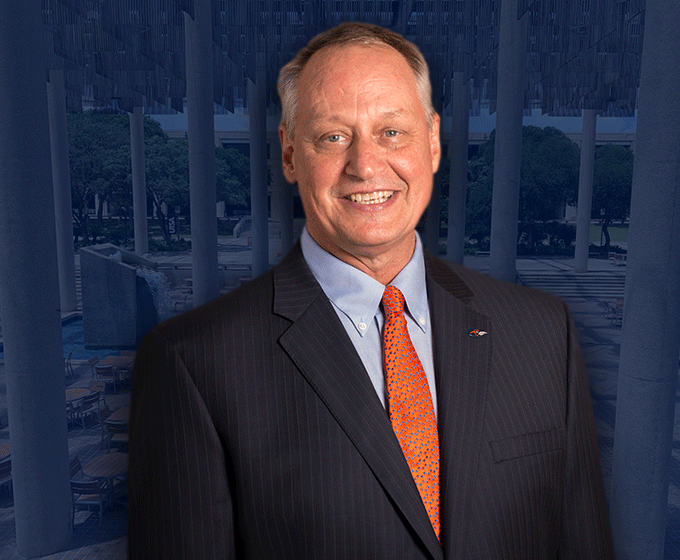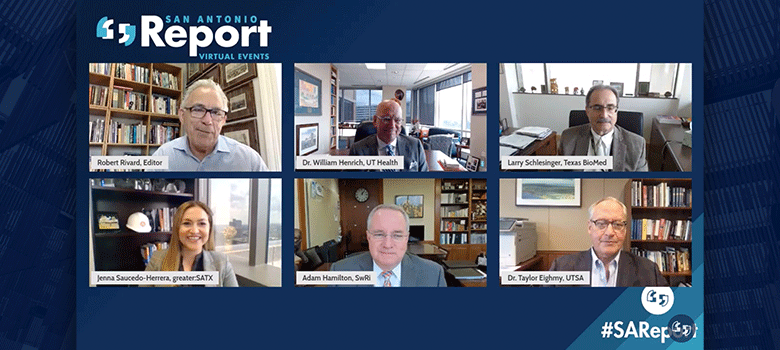
UTSA President Taylor Eighmy participated in a virtual discussion about the San Antonio Partnership for Precision Therapeutics on Thursday, September 30. UTSA is one of four institutions involved in the partnership aiming to create breakthrough treatments tailored to specific patient populations.
OCTOBER 1, 2021 — UTSA President Taylor Eighmy and other city leaders met virtually on Thursday to share the innovative efforts of the San Antonio Partnership for Precision Therapeutics (SAPPT), a billion-dollar partnership focused on creating breakthrough treatments tailored to specific patient populations, while serving as a model to improve health care in San Antonio, statewide and globally.
Eighmy joined his fellow SAPPT leaders, Adam Hamilton, president/CEO of Southwest Research Institute; William Henrich, president of UT Health San Antonio; and Larry Schlesinger, president/CEO of Texas Biomedical Research Institute. Jenna Saucedo-Herrera, president/CEO of Greater: SATX also participated in the event, a part of the 2021 Medical Forum Virtual Series hosted by San Antonio Report, an online publication.
During the virtual discussion, the panel guests provided an update on what is going on within the San Antonio Partnership for Precision Therapeutics, how the group moved forward amidst the COVID-19 pandemic and how the research collaborative benefits the city of San Antonio.

As part of its 2021 Medical Forum Virtual Series, San Antonio Report hosted an online discussion between leders of the San Antonio Partnership for Precision Therapeutics. Discussion participants were (clockwise, from top left): Robert Rivard, moderator and San Antonio Report editor; William Henrich, president of UT Health San Antonio; Larry Schlesinger, president and CEO of the Texas Biomedical Research Institute; Taylor Eighmy, president of UTSA; Adam Hamilton, president and CEO of the Southwest Research Institute; and Jenna Saucedo-Herrera, president and CEO of Greater: SATX.
“If you think about what’s transpired over the last year-and-a-half, our city, our community has been deeply impacted by this pandemic and this virus,” Eighmy said. “All four of our institutions had to pivot in profound ways. One of the things that is really remarkable about our partnership is amidst all the things we were working on, we got together with an urgency…to take the power of our partnership to address directly issues that were related to vaccine development to anti-viral therapy.”
Rather than sitting back and trying to make it through the pandemic, all four institutions were committed to working together to respond immediately to the needs nationally and in the San Antonio community, Eighmy added.
“It speaks to the nimbleness of our organizations. It speaks to our commitment about the power of this partnership,” Eighmy said. “This has been an opportunity to show the power of science.”
SAPPT uses precision medicine principles to maximize therapy effectiveness and seeks to provide solutions for diverse populations like the communities in the San Antonio region. It hopes to serve as a model for a team science approach to the development of therapies to improve medical treatment around the world.
Since its founding in 2019, the partnership has funded a total of seven research projects, including several collaborative COVID-19 research ventures. As a result of its seven projects, the partnership’s investigators have participated in 11 speaking events, including three international and five national appearances.
The partnership has received four grants and its researchers have published 10 scientific papers in some of the most competitive journals.
All four partnership representatives agreed that collaboration has accelerated at their respective institutions despite the challenges brought about by the pandemic.
“Most of the time in large cities where there are multiple research institutions, there are one-off collaborations that occur,” Henrich said. “But not the complementary collaborations we have here. Our collaboration has been organic … It’s been based on our friendship and our personal commitment to try and bring attention to a city that doesn’t get sufficient attention for its science expertise.”
This partnership’s impact extends beyond its research. It’s also making an impact on San Antonio’s economic growth and the expansion of the city’s talent pool.
In San Antonio, about one in five individuals are employed in the health care and biosciences industry. And for every federal dollar brought to the city, there is a multiplier of $5 to $7 in economic growth, Henrich said.
“The partnership is about growing the ecosystem. It’s about a self-fulfilling prophecy,” Saucedo-Herrera said. “What they’re doing today is going to position us for even more R&D [research and development]. It is going to position us for even more corporations and bioscience firms coming to San Antonio that will invest again in this self-sustaining model that is the partnership for precision therapy.”
UTSA Today is produced by University Communications and Marketing, the official news source of The University of Texas at San Antonio. Send your feedback to news@utsa.edu. Keep up-to-date on UTSA news by visiting UTSA Today. Connect with UTSA online at Facebook, Twitter, Youtube and Instagram.
Move In To COLFA is strongly recommended for new students in COLFA. It gives you the chance to learn about the Student Success Center, campus resources and meet new friends!
Academic Classroom: Lecture Hall (MH 2.01.10,) McKinney Humanities BldgWe invite you to join us for Birds Up! Downtown, an exciting welcome back event designed to connect students with the different departments at the Downtown Campus. Students will have the opportunity to learn about some of the departments on campus, gain access to different resources, and collect some giveaways!
Bill Miller PlazaCome and celebrate this year's homecoming at the Downtown Campus with food, games, giveaways, music, and more. We look forward to seeing your Roadrunner Spirit!
Bill Miller PlazaThe University of Texas at San Antonio is dedicated to the advancement of knowledge through research and discovery, teaching and learning, community engagement and public service. As an institution of access and excellence, UTSA embraces multicultural traditions and serves as a center for intellectual and creative resources as well as a catalyst for socioeconomic development and the commercialization of intellectual property - for Texas, the nation and the world.
To be a premier public research university, providing access to educational excellence and preparing citizen leaders for the global environment.
We encourage an environment of dialogue and discovery, where integrity, excellence, respect, collaboration and innovation are fostered.